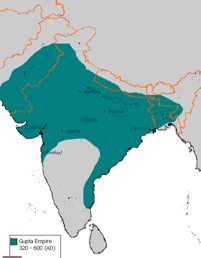Sign up for FlowVella
Sign up with FacebookAlready have an account? Sign in now
By registering you are agreeing to our
Terms of Service
Loading Flow




320 A.D.-550 A.D.
The Gupta Empire
The Golden Age
The Gupta Empire is known as the Golden Age because of its cultural advancements. It was founded by Chandra Gupta I in 320 A.D.
Achievements
By living in a time of peace and prosperity, the Gupta people made many scientific, mathematic, and artistic advancements. Religious institutions offered educations. Mathematicians developed the concept of zero, the decimal system, and Arabic numerals for writing. Architects began the institution of statues of gods in their temples.
Hinduism greatly impacted Gupta society. People were organized into classes in the caste system, a result of the belief that rules and tradition created a stable society. The ideal family was a joint family, where children and their children live with their parents. Marriages were arranged because a person had to marry within their caste. Over time, the role of women became increasingly more suppressed. Towards the end of Gupta rule, the rich women were restricted to their homes and had to be covered head to toe. The women in poorer classes, however, still had to work.
Society
Government
The Gupta empire had a strong central government, with some power given to local leaders.
Economy
Along with agriculture, the economy consisted of industry and trade. Major industries included textiles, pottery, and manufactured goods.

Gupta Empire
Kalidasa
Kalidasa was a gifted playwright and poet. His most famous play was called Shakuntala.
Shakuntala is about a king who marries a lovely orphan named Shakuntala. The king is then cast under a spell compelling him to forget her. After many twists and turns, the king eventually remembers Shakuntala.